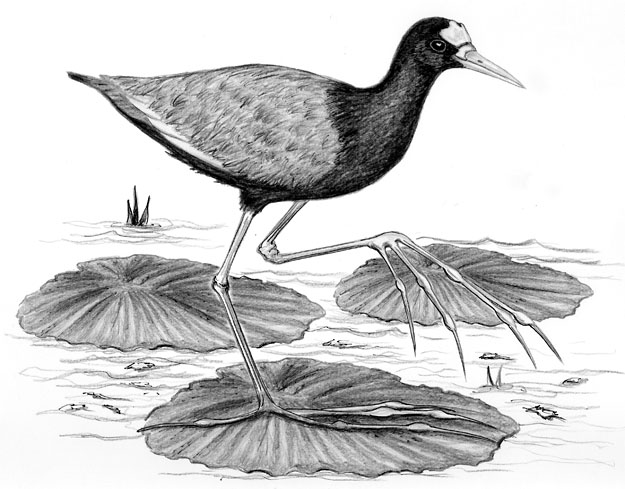
Dear Bird Folks,
I’ve just returned from Cancun, Mexico, where I did a little birding while the rest of the family did beachy stuff. The birds that caught my attention were the weird Northern Jacanas, which don’t look like anything we have in Cooperstown, NY. I’m wondering if you could tell me something about these freaky birds. In particular, I’d like to know why they are called “Northern” Jacanas, since tropical Mexico isn’t exactly in the north.
– Jackson, Cooperstown, NY
They’re aliens, Jackson,
Over the centuries people have become obsessed with the idea of Martians coming to our planet. They look for hidden signs in the writings of H.G. Wells or Jules Vern. They also study crop circles, read about Area 51, watch Star Trek and think that any light in the night sky is a spaceship coming to take us all away. Well, these people have been looking for aliens in all the wrong places. Aliens, in the form of little birds called “jacanas,” have been living undetected in Cancun, Mexico for thousands of years. Okay, fine. Jacanas aren’t aliens, but they are truly one of the strangest creatures you’ll ever see, even by Mexican standards.
How strange is a Northern Jacana? It’s a robin-sized shorebird that doesn’t like the shore. Its feet have long, creepy toes that look like E.T.’s hands and it has razor-sharp spurs growing out of its wings, which it uses for fighting and opening mail. It can remain underwater for long periods, without ever surfacing. In addition, the female is larger than the male and she does most of the territorial defense, while the little, hen-pecked male builds the nest and raises the kids. The jacana even has bizarre nicknames. Some countries call it the “Jesus bird;” in other locations it is called the “prostitute bird.” (Talk about extremes.) But most locals call it the “lily-trotter.” (Lily-trotter? No wonder the males get pushed around.) And speaking of names, do you know how to pronounce “jacana”? Don’t feel bad. No one else does, either. (I say “jah-kah-nah,” but don’t quote me on that.)
Most shorebirds feed by probing the beach for food hidden in the mud or sand. Somewhere along the line, jacanas decided the beaches were too hot and crowded, so they moved inland. There they found all kinds of yummy insects swimming on top of freshwater ponds and marshes. The problem was they couldn’t get to the yummy insects because the water was too deep. To solve this problem they grew ridiculously long toes. These long toes help disperse the birds’ weight, which allows them to walk on water, or so it seems. Lily pads or any smidgen of aquatic vegetation are all the jacanas need to stroll across the water. Thus the name lily-strollers or Jesus birds. (I still don’t know where the prostitute name comes from.)
While jacanas may be wonderful water-walkers, they aren’t great flyers. (Those long, gangly toes probably create too much drag.) So instead of flying when danger threatens, they have the peculiar habit of hiding underwater, duck-style. When it comes times for them to breathe, they don’t bob to the surface like a duck does; they simply push their nostrils slightly above the surface, while their bodies remain totally submerged. By using their snorkel-ish nostrils, the birds can hide from danger almost indefinitely.
Because jacanas live in the tropics, where the weather is always warm, anytime of year can be breeding season. A breeding female will stake out a large territory and try to attract several males. She may attract as many as four different males and each male will build a separate nest within her territory. The female will lay a clutch of eggs in each nest and then she goes someplace to relax. It will be the male’s job to incubate the eggs and raise the kids, while the female thinks about doing more breeding with more males. (Oh, now I get that other nickname.)
There are eight different species of jacanas in the world, with only two of them found in the Americas. There is the Wattled Jacana (how would you like to get stuck with that name?) and the aforementioned Northern Jacana. The bulk of the Waddled Jacanas live in South America, while the majority of the Northern Jacanas live in Central America, Mexico and the Caribbean. I’m guessing the Northern Jacanas are so named because they live “north” of South America, not because they are found in an area that we might consider north, like Cooperstown, NY. Not too long ago jacanas nested around Manor Lake in Texas. Unfortunately, the lake’s owners (it seems in Texas people can own their own lakes) didn’t like the aquatic vegetation that grew on the lake, so they gave it the NSTAR treatment and sprayed the lake with herbicide. That got rid the vegetation, as well as North America’s only breeding population of jacanas. Boo on them.
I’m glad you did some birding while you were in Cancun, Jackson. Years ago I vacationed there, too, and like you I was more interested in the birds than the beaches. It was spring break and my hotel was filled with partying college kids. Every evening I’d return to the hotel after hours of slugging around in the jungle, all dirty and sweaty, stinking of bug spray, with binoculars around my neck and a bird book sticking out of my pocket. I kept waiting for the kids to invite me to one of their parties, but they never did. To this day I have no idea why.